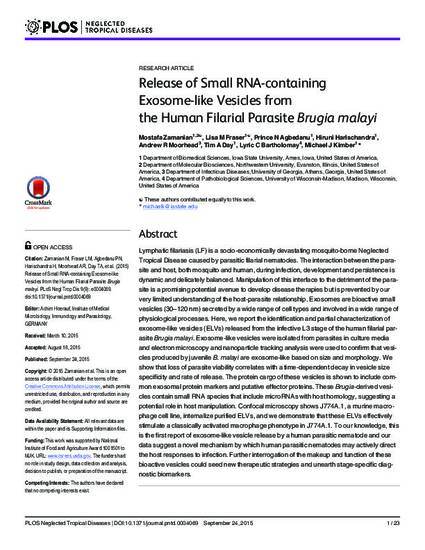
Lymphatic filariasis (LF) is a socio-economically devastating mosquito-borne Neglected Tropical Disease caused by parasitic filarial nematodes. The interaction between the parasite and host, both mosquito and human, during infection, development and persistence is dynamic and delicately balanced. Manipulation of this interface to the detriment of the parasite is a promising potential avenue to develop disease therapies but is prevented by our very limited understanding of the host-parasite relationship. Exosomes are bioactive small vesicles (30–120 nm) secreted by a wide range of cell types and involved in a wide range of physiological processes. Here, we report the identification and partial characterization of exosome-like vesicles (ELVs) released from the infective L3 stage of the human filarial parasite Brugia malayi. Exosome-like vesicles were isolated from parasites in culture media and electron microscopy and nanoparticle tracking analysis were used to confirm that vesicles produced by juvenile B. malayi are exosome-like based on size and morphology. We show that loss of parasite viability correlates with a time-dependent decay in vesicle size specificity and rate of release. The protein cargo of these vesicles is shown to include common exosomal protein markers and putative effector proteins. These Brugia-derived vesicles contain small RNA species that include microRNAs with host homology, suggesting a potential role in host manipulation. Confocal microscopy shows J774A.1, a murine macrophage cell line, internalize purified ELVs, and we demonstrate that these ELVs effectively stimulate a classically activated macrophage phenotype in J774A.1. To our knowledge, this is the first report of exosome-like vesicle release by a human parasitic nematode and our data suggest a novel mechanism by which human parasitic nematodes may actively direct the host responses to infection. Further interrogation of the makeup and function of these bioactive vesicles could seed new therapeutic strategies and unearth stage-specific diagnostic biomarkers.
Available at: http://works.bepress.com/michael-kimber/8/

This article is from PLoS Negl Trop Dis 9(9): e0004069. doi:10.1371/journal.pntd.0004069. Posted with permission.